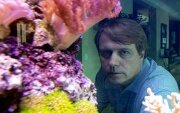Marine Water Quality
From Microcosm Aquarium Explorer
“You can’t cross the sea by merely standing and staring at the water.” —Lawrence J. Peter
Water Testing
Knowing & Tracking the Key Measures
By Carl DelFavero
When asked to give help or advice to a marine hobbyist with a problem, I find that the subject of water quality comes up almost instantly.
Quite often, when I ask how someone’s water quality is I get an answer like “Fine.”
I can be of little help to the person who responds in this way because I do not know what he or she means by “fine.” I cannot stress too strongly how important it is to be able to describe your water conditions using the simple measures we all need to know.
As marine aquarists, we measure the water quality in our aquariums against the vital parameters of natural seawater on coral reefs. You do not have to become fixated by chemistry, but anyone who wants to keep a healthy marine tank needs to know what the key water quality factors are, how to test for them, and how to correct problems and bring the readings back within safe bounds if they are found to be outside our goals.
There is one truth we need to acknowledge: no one can judge the quality of water with the naked eye. We can, of course, note murkiness or discoloration, but no one can eyeball the presence of toxic nitrite or phosphate or low levels of essential calcium, so periodic water quality testing is a vital part of aquarium maintenance.
You should develop a good understanding of each of the tests outlined in the list below as well as with proper laboratory technique.
You will soon get accustomed to the measurement scales of each type of test and begin using appropriate terminology when speaking to other aquarists or seeking advice. When communicating water quality parameters always use proper numbers and units. Doing so will convey precise information about the condition of the water and make meaningful analysis much easier.
The accompanying chart lists the most common units used in water testing for the marine aquarium. Many tests are expressed in parts per million. That is, for every one million parts of the water sample, there is one part of the substance we are testing for. Think of how sensitive the test must be if its units of measure are in the tenths of a part per million, as is the case with ammonia.
With such sensitive tests, good laboratory procedure is essential for accurate test results. By forming the habit of using proper procedures right from the beginning, you will be able to count on more reliable readings immediately and better long-term records in the future.
Basic Marine Water Tests
- Temperature
- Specific Gravity
- pH
- Ammonia, Nitrite and Nitrate
Reefkeeping Tests
- Alkalinity
- Calcium
- Phosphate
Proper Laboratory Procedure
- Understand all steps of the test being performed prior to beginning the test.
- Rinse all test equipment (test tubes, syringes, etc.) with sample water from the aquarium prior to testing.
- Perform the test exactly as described in the instructions.
- If the test is to be timed, time the test exactly.
- Log the results of each test on a log sheet and, ideally, and on a graph.
- After each test, carefully wash the test tubes, syringes, etc. and rinse them in distilled or deionized water. Do not assume that reverse-osmosis (RO) water is pure enough for the final rinse.
- Dry all components of each test kit and store them away for the next use.
Detailed Water Quality Resources
— Carl DelFavero
Reference: Aquarium Keeping and Rescue









